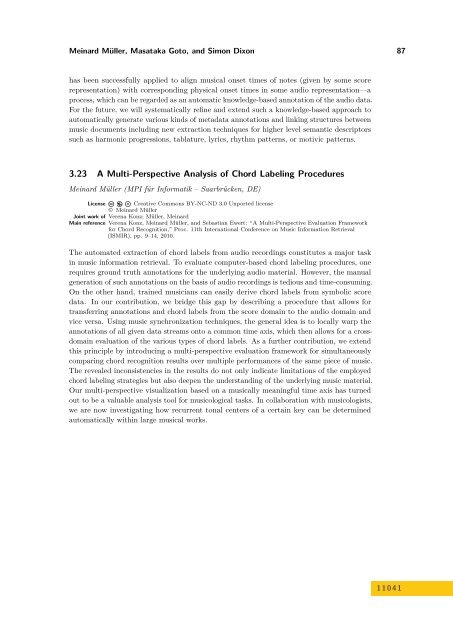Volume 1, Issue 1, January 2011 - DROPS - Schloss Dagstuhl
Volume 1, Issue 1, January 2011 - DROPS - Schloss Dagstuhl
Volume 1, Issue 1, January 2011 - DROPS - Schloss Dagstuhl
You also want an ePaper? Increase the reach of your titles
YUMPU automatically turns print PDFs into web optimized ePapers that Google loves.
Meinard Müller, Masataka Goto, and Simon Dixon 87<br />
has been successfully applied to align musical onset times of notes (given by some score<br />
representation) with corresponding physical onset times in some audio representation—a<br />
process, which can be regarded as an automatic knowledge-based annotation of the audio data.<br />
For the future, we will systematically refine and extend such a knowledge-based approach to<br />
automatically generate various kinds of metadata annotations and linking structures between<br />
music documents including new extraction techniques for higher level semantic descriptors<br />
such as harmonic progressions, tablature, lyrics, rhythm patterns, or motivic patterns.<br />
3.23 A Multi-Perspective Analysis of Chord Labeling Procedures<br />
Meinard Müller (MPI für Informatik – Saarbrücken, DE)<br />
License Creative Commons BY-NC-ND 3.0 Unported license<br />
© Meinard Müller<br />
Joint work of Verena Konz; Müller, Meinard<br />
Main reference Verena Konz, Meinard Müller, and Sebastian Ewert: “A Multi-Perspective Evaluation Framework<br />
for Chord Recognition,” Proc. 11th International Conference on Music Information Retrieval<br />
(ISMIR), pp. 9–14, 2010.<br />
The automated extraction of chord labels from audio recordings constitutes a major task<br />
in music information retrieval. To evaluate computer-based chord labeling procedures, one<br />
requires ground truth annotations for the underlying audio material. However, the manual<br />
generation of such annotations on the basis of audio recordings is tedious and time-consuming.<br />
On the other hand, trained musicians can easily derive chord labels from symbolic score<br />
data. In our contribution, we bridge this gap by describing a procedure that allows for<br />
transferring annotations and chord labels from the score domain to the audio domain and<br />
vice versa. Using music synchronization techniques, the general idea is to locally warp the<br />
annotations of all given data streams onto a common time axis, which then allows for a crossdomain<br />
evaluation of the various types of chord labels. As a further contribution, we extend<br />
this principle by introducing a multi-perspective evaluation framework for simultaneously<br />
comparing chord recognition results over multiple performances of the same piece of music.<br />
The revealed inconsistencies in the results do not only indicate limitations of the employed<br />
chord labeling strategies but also deepen the understanding of the underlying music material.<br />
Our multi-perspective visualization based on a musically meaningful time axis has turned<br />
out to be a valuable analysis tool for musicological tasks. In collaboration with musicologists,<br />
we are now investigating how recurrent tonal centers of a certain key can be determined<br />
automatically within large musical works.<br />
1 1 0 4 1













